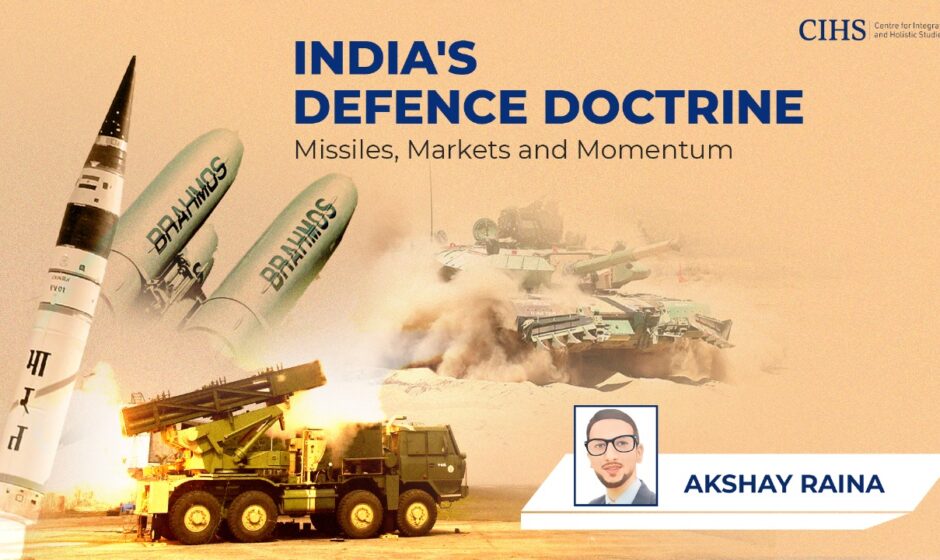India’s defence sector is undergoing a strategic renaissance evolving from self-reliance to global leadership as an exporter of cutting-edge, indigenous military technologies and a trusted partner in the international security architecture.
Akshay Raina
When it comes to national security, a country’s ability to rely on its own resources in times of conflict is crucial. For India, a rapidly growing global power with diverse security concerns, achieving self-reliance in defence production has become a top priority. This shift from dependency to self-sufficiency is no longer just a strategic aim; it’s a vital step toward safeguarding India’s defence needs while simultaneously strengthening its position in the global defence market. The country’s focus on enhancing indigenous defence production, through initiatives like Make in India, has completely transformed the landscape of defence manufacturing. In recent years, India has dramatically reduced its dependence on foreign imports, thanks to forward-thinking policies, increased collaboration between government agencies and private industries, and a strong emphasis on developing homegrown defence technologies. These efforts have also contributed to a significant rise in defence exports, signalling India’s emerging role as a major global defence producer and exporter.
From Import Dependency to Self-Reliance
India has historically been one of the world’s largest importers of defence equipment. However, this trend is rapidly changing. The introduction of the Defence Acquisition Procedure (DAP) 2020 by the Ministry of Defence was a pivotal move in this transformation. The DAP focuses on promoting the indigenization of defence production, strengthening India’s military capabilities and reducing the country’s reliance on foreign suppliers for key military hardware. A key aspect of this procedure has been the development of indigenization lists, alongside fostering innovation from domestic startups and MSMEs (Micro, Small, and Medium Enterprises), which are now integral to India’s defence ecosystem. The government’s investment in defence corridors and its efforts to promote collaboration between public sector undertakings (PSUs) and private entities have further accelerated this progress. Moreover, the relaxation of Foreign Direct Investment (FDI) limits in defence has encouraged global defence companies to establish manufacturing hubs in India, helping to fuel the growth of the domestic defence industry.
Milestones in Indigenous Defence Production
India’s move toward self-sufficiency in defence is marked by significant technological advancements and strategic achievements. India’s capabilities in defence manufacturing are no longer limited to just assembling products; the country is now designing and producing world-class technologies for its defence needs.
Some of India’s notable indigenous defence products include:
- INS Arihant: India’s first indigenous nuclear submarine, developed by Baba Atomic Research Centre (BARC) and Defence Research and Development Organisation (DRDO), which strengthens the nation’s nuclear deterrence capabilities.
- Agni V: An intercontinental ballistic missile (ICBM) that boosts India’s long-range strike capabilities.
- Pinaka Multi-Barrel Rocket Launcher: Developed by Research & Development Establishment (Engineers), Pune (RDE), this system enhances India’s artillery strength.
- Arjun Tank: A third-generation main battle tank developed by DRDO and produced by Indian Ordnance Factories, vital for India’s land defence.
- Varunastra, Maareech, Ushus: Advanced torpedoes that showcase India’s underwater warfare capabilities.
These products, alongside ongoing advancements in electronic warfare, radar technologies, and advanced fighter jets, exemplify India’s growing capability to design, develop and produce defence technologies to meet its strategic needs. With sustained investments in research and development, India is poised to reduce its dependence on foreign defence imports even further.
India’s Expanding Defence Export Market
India’s increasing self-reliance in defence is not only reducing the country’s dependence on imports but is also positioning India as a significant player in the global defence export market. Over 100 countries now purchase defence products from India, including helicopters, naval vessels, missiles, armored vehicles and aircraft. The rise in defence exports is largely attributed to the government’s focus on high-quality manufacturing, innovative technologies and streamlining the defence procurement process.
Key achievements in India’s defence exports include:
- In 2023-24: India’s defence exports hit ₹21,083 crore, marking a 32.5% growth from the previous year, positioning India as an emerging defence export powerhouse.
- BrahMos Exports: India secured a reported $375 million deal with the Philippines for BrahMos supersonic cruise missiles, highlighting its ability to export high-end defence technology.
- Diversified Export Markets: India’s defence products are now being exported to countries like the USA, France, Armenia and several others, reflecting the growing global demand for Indian-made defence products.
For instance, as per recent reports, India supplied over $250 million worth of Pinaka multi-barrel rocket launchers, anti-tank munitions and other ammunition to Armenia in 2022. India has also exported naval platforms and torpedoes to Mauritius, Myanmar, Sri Lanka and Vietnam and military trucks to Thailand. Additionally, Tata 8×8 LPTA trucks, based on the Tata 1623 platform, are being exported to the Royal Moroccan Army, marking another achievement in India’s defence exports.
Future of India’s Defence Exports
India’s defence exports are on an upward trajectory. As the country enhances its defence production capabilities, its growing export footprint positions India as a trusted supplier of affordable, high-quality defence products. The government’s ambitious target of reaching ₹50,000 crore in defence exports by 2029 reflects India’s determination to become a global leader in defence manufacturing. This rise in exports is not just about economics—it’s also about strengthening India’s strategic alliances globally. Deals with countries like the UAE, Armenia and Myanmar reflect India’s growing influence and the trust placed in its defence capabilities. By providing cutting-edge defence solutions at competitive prices, India is offering an alternative to traditional Western and Russian defence suppliers, which only further solidifies the country’s position in the global defence market.
India’s Strategic Vision for Global Defence Leadership
India’s defence sector has undergone a remarkable transformation over the past decade. Once one of the world’s largest importers of defence equipment, India is now rapidly becoming a top producer and exporter of world-class defence technologies. The government’s support for indigenous defence production, increased foreign investments and strategic initiatives like the Defence Acquisition Procedure (DAP) 2020 have paved the way for India to become self-reliant in defence production. India’s defence exports have surged significantly, from ₹686 crore in 2014-15 to ₹21,083 crore in 2023-24. With cutting-edge products like BrahMos, Pinaka and Tata 8×8 trucks, India is providing high-quality, reliable, and affordable defence solutions to the world. The country’s goal of achieving ₹50,000 crore in defence exports by 2029 is a clear indicator of India’s growing influence on the global defence stage. As the geopolitical landscape evolves, India’s role as a trusted defence partner and manufacturing leader will continue to grow, securing both its own defence needs and its position as a global strategic power. By prioritizing self-reliance, innovation and global partnerships, India is not just preparing for its future defence requirements but is also positioning itself as a leader in the global defence market.
(Author is a seasoned media professional, content strategist and news analyst)



